



Beim diesjährigen Wettbewerb für Kunst im Untergrund, NACH DER ARBEIT, gab es 380 Einreichungen, also mehr als doppelt so viele wie im letzten Jahr. Der Großteil der Bewerbungen von Künstler_innen verschiedenster Nationalitäten erreichte uns aus Berlin. Doch auch aus dem übrigen Europa, aus Australien, Japan, Kanada und den USA kamen viele Einsendungen. Das Preisgericht hat insgesamt 13 Entwürfe zur Realisierung vorgeschlagen, die ortsspezifisch und thematisch arbeiten. Die Arbeiten der zweiten Realisierungsphase ergänzen nun die der ersten Phase um 6 weitere Beiträge – nunmehr auf 15 Bahnhöfen.
This year’s edition of the competition for art on the underground, AFTER WORK, attracted 380 entries – over twice as many as last year. The majority of applications submitted by artists of various nationalities came from artists based in Berlin. However, there were also many submissions from the rest of Europe and from Australia, Canada, Japan and the USA. The competition jury recommended thirteen proposals for implementation that operate in a site- and subject-specific manner. The works in the second phase of implementation will add a further six installations to those of the first phase; there are now installations in a total of fifteen stations.
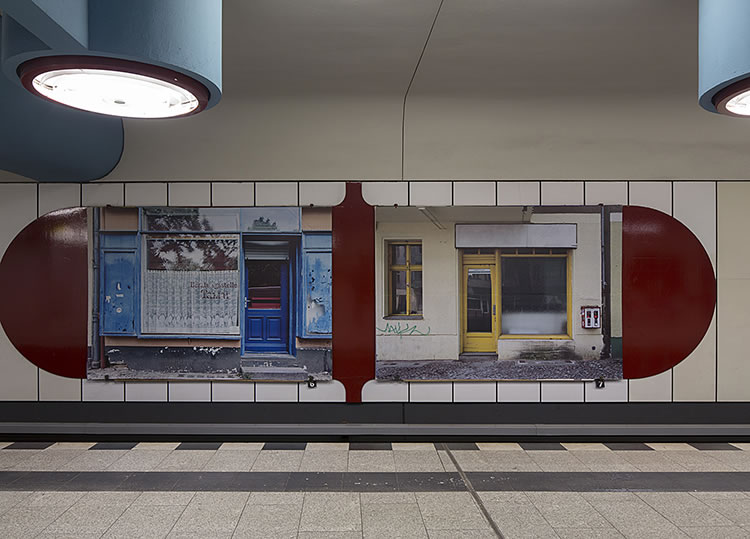
Shops und Ladenfronten sind auch Indikatoren für den Wandel von Bevölkerungsstrukturen, von sozialer Segregation. Gleichzeitig sind Ladenräume auch Oasen des individualisierten Gewerbes und der Kreativität. Dieses Spannungsfeld exemplifiziert sich ganz besonders in der Umgebung des Nauener Platzes. Neben den sozialen Implikationen haben diese Ladenfronten formal-ästhetische Qualitäten und eine besondere Bildhaftigkeit. Auf einer abstrakten Ebene korrespondieren die auf die Bildebene bezogenen Kompositionen mit dem 70er-Jahre-Design des U-Bahnhofs Nauener Platz.
Shops and shopfronts are also indicators for changes in population structures and in social segregation. At the same time, shop spaces are also oases of individualised commerce and creativity. This dynamic can be observed around Nauener Platz in particular. Alongside the social implications of these shopfronts, they also have formal-aesthetic qualities and a particular visual quality. On an abstract level, the image-related compositions correspond with the 1970s design of Nauener Platz underground station.
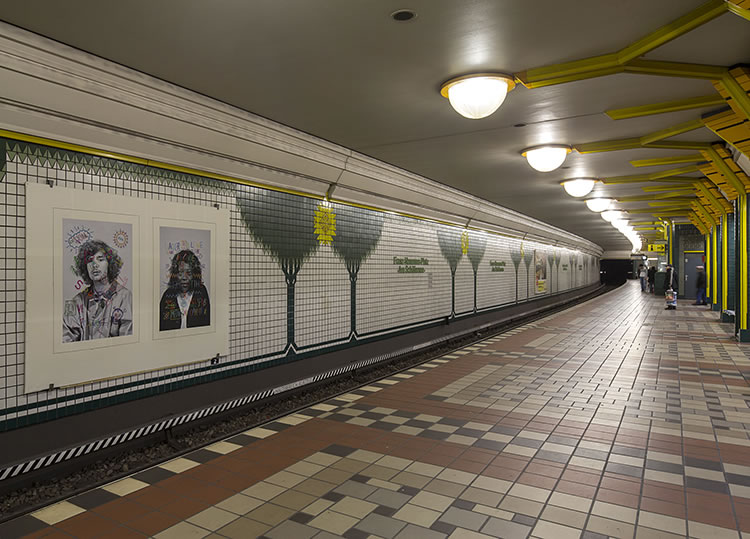
Portraits werden mit Hilfe von bunten Stickereien neu interpretiert. Der so entstehende Gegensatz verleiht dem Bild eine neue, ungeahnte Aussagekraft, ergänzt es um eine schwer in Worte zu fassende Ebene. Die Bilder geben somit keine detaillierte Auskunft über das Leben eines Individuums, sondern transportieren Lebensgefühle. In den Arbeiten kommen die Emotionen einiger, meist junger Menschen zum Ausdruck. Denn die bunte Mischung der Gesell-schaft, die für eine besondere Lebensqualität im Viertel verantwortlich ist, beeinflusst alle Anwohner.
Portraits are re-interpreted with the aid of colourful embroidery. The resulting juxtaposition lends the image a new, unimagined expressive power and adds to it a level that is difficult to capture in words. The images thus do not provide detailed information about the life of an individual, but instead convey lifestyle attitudes. The emotions of a number of mostly young people are expressed in these works. After all, the diversity of the community, which is responsible for the particular quality of life in a neighbourhood, is felt by all residents.
Die Arbeit „NO WALLS“ im U-Bahnhof Bernauer Straße bezieht sich auf Berlins Geschichte als geteilte Stadt. Das Projekt umfasst Gegenwart und Vergangenheit und richtet seine Aufmerksamkeit auf die Menschen, die damals wie heute hier lebten und leben.
Die Bilder sind schwarz-weiße Collagen aus Zeichnungen und Fotografien – aufgenommen in der Nähe des U-Bahnhofs auf beiden Seiten der Straße, durch die die Mauer einst verlief.
Auf der Grundlage vorgefundenen Bildmaterials entstanden gezeichnete Silhouetten, die Eingang in die Arbeiten fanden. Die Schatten der Vergangenheit verschmelzen mit der heutigen Realität. Die Mauer existiert physisch nicht mehr, aber immer noch in unserer Wahrnehmung.
Bernauer Strasse became famous as the Berlin Wall ran along the street, and it was the scene of escapes from the windows of apartment blocks in the eastern part onto the street below, which was in West Berlin. Nowadays, Bernauer Strasse underground station is the starting point for many tourists who wish to see the remains of the Wall and the Wall Memorial. This work connects the station with the location and the present with the past, with a focus on the people living there now and then.
In the images, three points were chosen on Bernauer Strasse close to the station and photographed from both sides of the street. Those photos then served as the background for a collage that includes silhouette images taken from other photos that are related to the history of the Berlin Wall. Shadows from the past thus merge into today’s reality. The Wall does not physically exist any more, but still remains in our perception.
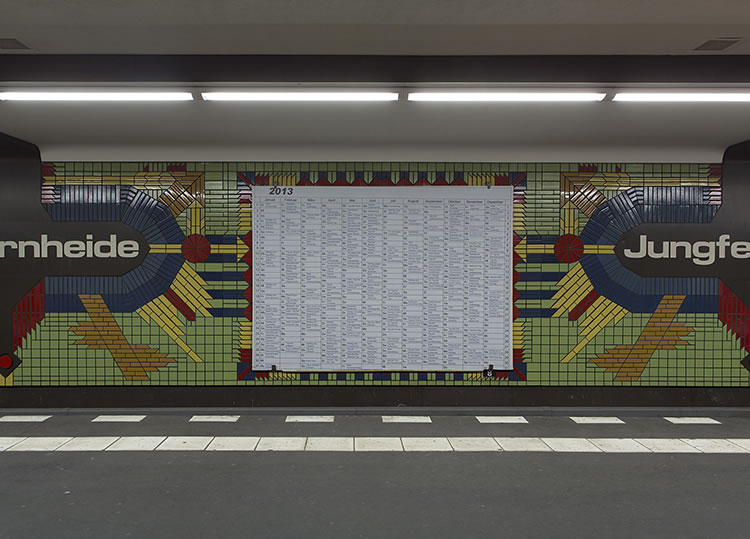
Der Beitrag „Am 13. August ist Linkshändertag“ zeigt eine Übersicht von internationalen, europäischen und nationalen Aktionstagen, dargestellt als Einträge in einem neutralen Jahresübersichtskalender. Aktionstage informieren, jährlich wiederkehrend, in erster Linie über gesellschaftspolitische oder medizinische Problemlagen und Ereignisse. Es gibt jedoch auch eine Vielzahl von privat oder kommerziell initiierten Aktionstagen, bis hin zur Proklamation von Aktionstagen Einzelner, die dadurch auf einen besonderen Sachverhalt oder auf sich selbst aufmerksam machen wollen. Die hier dargestellten Aktionstage (mehrheitlich von der UNO oder internationalen Verbänden initiiert) zeigen die Bandbreite menschlicher Aktion und deren gesellschaftspolitischer Manifestation auf.
The “13 August is Left-Handers’ Day” project presents an overview of international, European and national action days, which are displayed as entries on a neutral calendar. Action days occur annually and generally aim to increase awareness of socio-political or medical issues and events. There are also many privately or commercially initiated action days – right through to the proclamation of action days by individuals – that aim to draw attention to a particular situation or to the people themselves. The action days presented here (mostly initiated by the UN or international associations) show the broad spectrum of human campaigns and their socio-political manifestations.
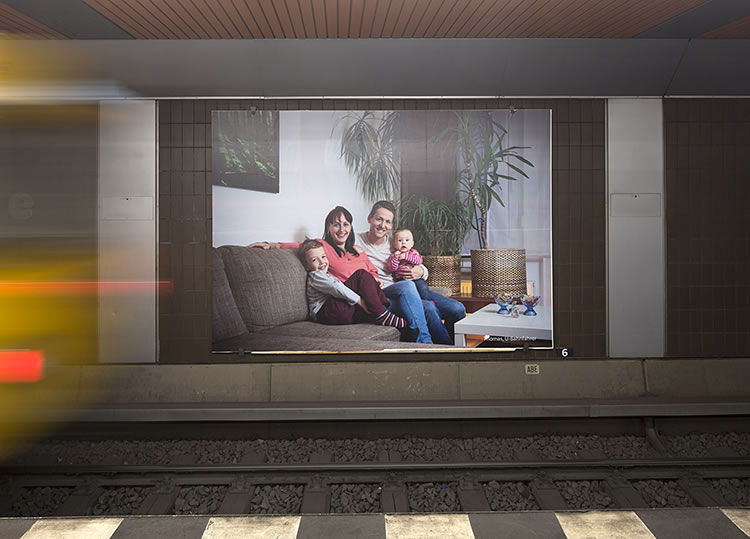
Das Projekt „Nach Hause Fahren“ zeigt U-Bahnfahrer_innen sowie Menschen, die im Umfeld der U-Bahn arbeiten und die bereit waren, sich in ihrem Zuhause porträtieren zu lassen. Damit soll einigen der Menschen, die uns jeden Tag durch Berlin fahren oder in U-Bahnstationen arbeiten, ein „Gesicht gegeben“ werden.Ziel ist es, eine Verknüpfung zwischen den Orten „Zuhause“ und „U-Bahnstation“ zu schaffen, um die Individualität dieser Menschen zu zeigen.
The “Nach Hause Fahren” project shows U-Bahn drivers and other people whose work is associated with the underground, all of whom were willing to be photographed at home. These portraits will give a face to people who transport us through Berlin every day or who work in underground stations. The aim is to create a link between the locations of “home” and “underground station” in order to demonstrate the individuality of these people.
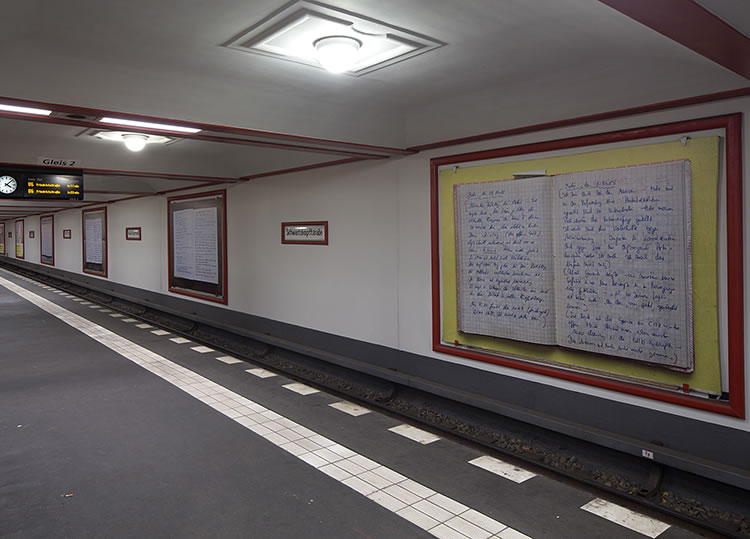
Im Umkreis des U-Bahnhofs Schwartzkopffstraße hat Carla Åhlander für ihr Projekt „Perspektiven“ Tagebücher gesammelt, aus denen sie einzelne Doppelseiten auswählte.
Die Spannung der Arbeit entsteht vor allem dadurch, dass das Intime der Tagebücher publik gemacht wird und damit im Kontrast zur anonymen Umgebung des U-Bahnhofs steht.
Weil die Tagebücher in den Wohnungen der jeweiligen Schreiber_innen fotografiert wurden, kann man auf den Fotos nicht nur die einzelnen Einträge in individueller Handschrift, sondern auch den Untergrund, auf dem die Bücher liegen (Tischdecke, Tischplatte), erkennen. Der/die Betrachter_in zieht aus diesen minimalen Informationen Rückschlüsse auf die Person und beginnt möglicherweise, sich diese vorzustellen. Welche Geschichte wird hier geschrieben, welche Bilder entstehen dabei im Kopf? Es wird eine Brücke zwischen privatem und kollektivem Gedächtnis geschaffen.
The “Perspectives” project will be exhibited at Schwarzkopffstrasse underground station.
Carla Åhlander collected diaries in the vicinity of the station and selected individual excerpts from these diaries. Enlarged photographed images of double spreads from these diaries are shown on the poster display units.
Diaries are usually not intended for publication: instead, private experiences, moods and feelings are noted here. What almost all diaries have in common is their high degree of subjectivity and their fragmentary nature.
Carla Åhlander: “Initially thought I would just scan the diaries, but then I realized that the photos I took for my own documentation created the room as well. It tells a story about the room, the situation, the person who is writing. It is about recognizing, you might recognize a material or a colour and this way you can identify much more. It might reflect back to your own thoughts.”
The allure of this work results primarily from the fact that intimate diaries are made public and that these diaries also contrast with the anonymous surroundings of the underground station. Each of the posters shows an excerpt from the diary of a single person. Due to the fact that the diaries were photographed in the apartments of the diarists and that the background (e.g. tablecloth, tabletop) can also be recognised alongside the individual diary entries with the person’s own handwriting, the observer can draw conclusions about the person from these minimal pieces of information and may even begin to be able to imagine the person. One starts to wonder how old the person is, and what does the person remind us of? Which story is being written here, what images are created in the observer’s mind?
A bridge between private and collective memory is thus created.
Carla Åhlander: “It was the idea to try to describe a place through the stories of people who live there. To give a portrait of a place through people’s inner thoughts, their private thoughts. Rather than through a kind of official history. When I read the diaries, they started to contextualize each other and to describe a mental space.”
The quotes are taken from a conversation between Carla Åhlander and Janine Sack.
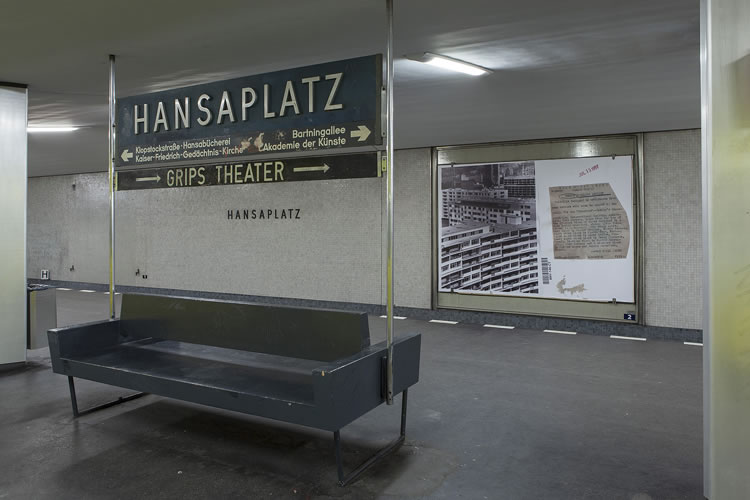
Berlin reloaded
Meine Beiträge zum Projekt referieren auf historische berlinbezogene Pressefotografien aufgelöster Arbeitsarchive ausländischer Tageszeitungen und Wochenmagazine. Die von mir ortsbezogen ausgewählten Fotografien und Texte, die aktuelle Ereignisse der Vergangenheit beschreiben, habe ich digital bearbeitet, um sie in diesen neuen öffentlichen Kontext zu bringen. Die Bilder bewegen sich im Spannungsfeld scheinbar aktueller und gleichzeitig vergangener Bild- und Textwelten an einem ungewöhnlichen Ort. Die Zuordnung und Auflösung der Irritation wird den Wartenden am Bahnsteig überlassen.
Berlin reloaded
My submissions for this project refer to historical, Berlin-related press photographs from the discontinued archives of foreign newspapers and weekly magazines. I have digitally processed the site-specific photographs and texts that I have selected and which describe past occurrences in order to adapt them for this new, public context. The photos operate between the twin poles of apparently current and, at the same time, historical visual and text-based imagery at a remarkable location. It is left up to those waiting on the platform to decode and resolve the irritation that results.
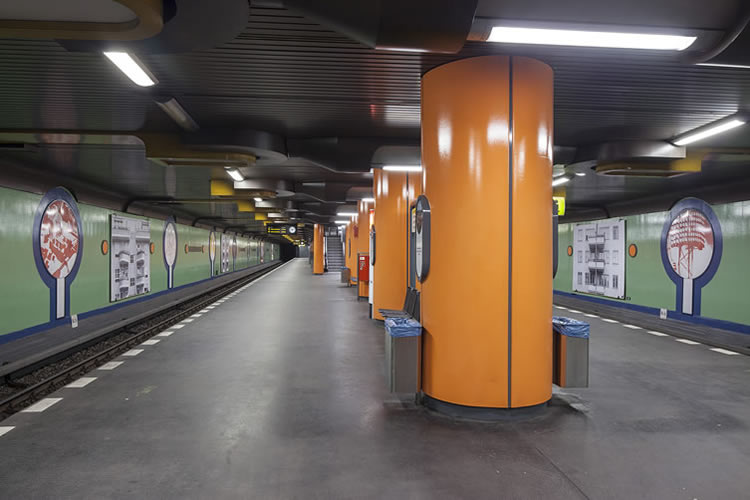
Balkonporträts
Mit den Balkonporträts wird die Aufmerksamkeit auf den Balkon als Lebensraum für den Menschen gelenkt. Er dient als Ort der Erholung „nach der Arbeit“. Die Großformatfotografien zeigen die Typologien der Balkone der Ringsiedlung in der Siemensstadt, welche seit 2008 zum UNESCO-Weltkulturerbe gehört. Die fotografierten Balkone bilden eines der Hauptcharakteristika für die in Zeilen angeordneten Geschosswohnungen dieser Siedlung des sozialen Wohnungsbaus. Die Siedlungen der 1920er Jahre sollten zur Verbesserung der Wohn- und Lebensverhältnisse breiter Bevölkerungsschichten beitragen. Die plakatierten Balkonportraits in der U-Bahnstation strukturieren den Ort neu. Als Außenraummotiv im Innenraum der U-Bahn schaffen sie eine architektonische Irritation.
Balcony portraits
With her “Balcony portraits”, Alexandra Spiegel directs our attention to balconies as part of people’s living environments. Balconies serve as a place of relaxation “after work”. These large-scale photographs depict various types of balconies in the so-called ‘Ring Estate’ in Berlin’s historical Siemensstadt residential development, which has been a UNESCO World Heritage Site since 2008. The balconies captured in the photographs are one of the most prominent features of the apartment blocks laid-out in rows in this public housing project. The housing developments built in the 1920s aimed to improve the living conditions of broad sections of the population. When put on display in poster form inside the underground station, the photos of the balconies serve to restructure this location: as an outdoor motif in the indoor environment of Berlin’s U-Bahn, they create an architectural irritation in this new context.
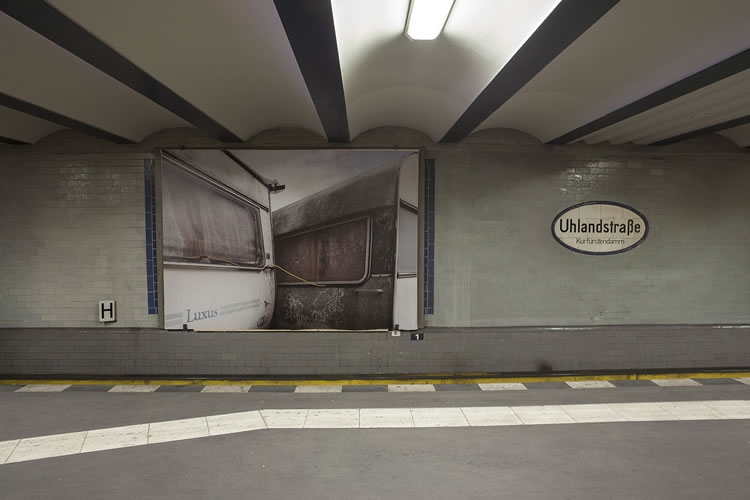
LUXUS
Familiäre Schauplätze, an denen sich kurz vor dem Verschwinden die Erinnerung an das Erlebte von den Dingen löst. Fragmente aus der Zeit gefallener Alltäglichkeiten sind uns auf einmal ganz fremd. Zu spät, um zu gehen, wenn es am schönsten ist.
LUXURY
Familiar locations where memories of past experiences become detached from objects shortly before they disappear. Fragments of everyday features from the past suddenly become very alien to us. It is too late to leave when things are at their most beautiful.
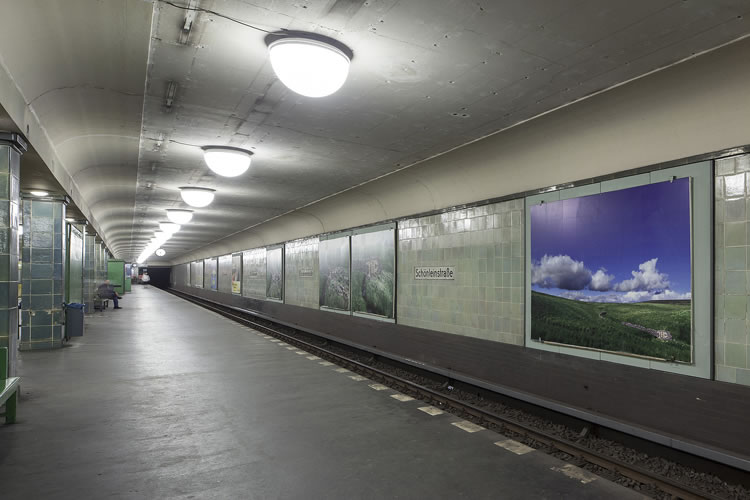
THC for Schönleinstrasse
Die Bilderserie dokumentiert die Errichtung einer Bruchsteinmauer in der englischen Provinz, in die der „tag“ THC, die Abkürzung für Tetrahydrocannibinol, den Wirkstoff im Marihuana, eingebaut ist. Als schnell hingeworfenes Graffiti kann man es oft in Berlin sehen, vor allem in Kreuzberg und Neukölln. Ich gebrauche es als ein Symbol für Berlin, welches ich in der sehr ländlich geprägten Gegend von Northumberland nachbilde, und sobald es fertig ist, in die Stadt seines Ursprungs zurückbringe. So wird ein Link und eine direkte Verbindung zwischen diesen beiden – nun verschwisterten – Orten hergestellt.
THC for Schönleinstrasse
This series of images documents the construction of a rubblework wall in the English countryside where a THC ‘tag’ has been built into the wall – THC is the ’abbreviation for tetrahydrocannabinol, the active agent in marijuana. This casually sprayed piece of graffiti can be seen often in Berlin, particularly in Kreuzberg and Neukölln. I use it as a symbol for Berlin, which I reproduce in the very rural area of Northumberland and, as soon as it is finished, then return to the city where it has its origins. In this way, a link and direct connection is created between these two locations, which are now twinned.
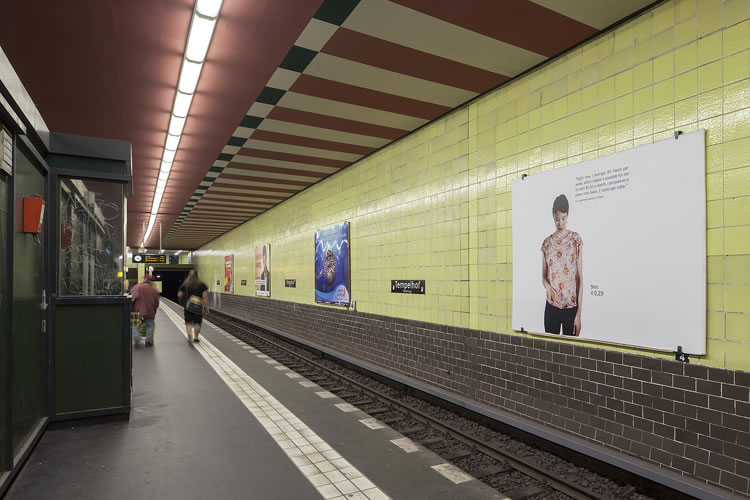
beyond fashion
Die Arbeit thematisiert die Schattenseiten der globalisierten Modeindustrie. Dazu wurden verschiedene Kleidungsstücke im Stil klassischer Fashion-Shootings inszeniert. Zitate von Arbeiter_innen über die Arbeitsbedingungen bei der Herstellung dieser Kleidungsstücke bestimmten die jeweilige fotografische Inszenierung. In Anlehnung an die verbreitete Werbeästhetik zielt die Arbeit darauf ab, den/die Betrachter_in als Konsument_in der „beworbenen“ Kleidung anzusprechen und gleichzeitig jenen eine Stimme zu verschaffen, die den wahren Preis im heutigen „Fast Fashion Business“ bezahlen.
beyond fashion
My “Beyond fashion” project deals with the dark side of the globalised fashion industry. Various items of clothing are showcased here in the style of conventional fashion photo shoots. However, quotes from female employees regarding the working conditions during the manufacture of these items of clothing define the photographic presentation in each case. Borrowing from the widely used advertising aesthetic, this work aims to address the observer as the consumer of the clothing being advertised and, at the same time, to give a voice to those who pay the true price of today’s “fast fashion business”.
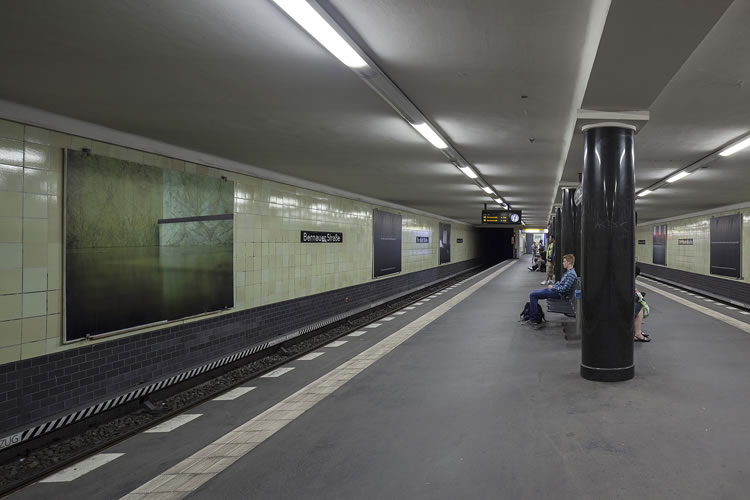
OBLIQUE – Geisterbahnhof
In Südafrika geboren, habe ich meine Kindheit und Jugend unter der Apartheid verbracht und als Jugendlicher bzw. junger Erwachsener den Übergang zu einer demokratischen Gesellschaft miterlebt. Dieser Übergang hat mich und meine künstlerische Praxis nachhaltig geprägt: das Verwerfen alter Ideologien, die Anpassung an neue politische und kulturelle Identitäten sowie die intensive Bewältigung einer traumatischen und gewalttätigen Vergangenheit.
Seit 2007 lebe ich als Einwanderer mit meiner Familie in Deutschland und reise zwei bis drei Mal im Jahr nach Südafrika. Mein Interesse hat sich seitdem zunehmend auf die Ähnlichkeiten zwischen den beiden Orten verlagert, die beide zeitgleich tief greifende politische und gesellschaftliche Änderungen erfahren haben. Mich interessiert, auf welch unterschiedliche Weise sich diese ideologischen Gräben im urbanen und psychologischen Gefüge der jeweiligen Orte manifestieren – sei es als sichtbare Narben in der Landschaft oder als unsichtbare physiologische Merkmale.
OBLIQUE – Ghost station
I was born in South Africa, spent my childhood and youth there under apartheid, and later on experienced the transition to a democratic society as a young adult. This transition influenced me and my artistic practice in a lasting manner: the discarding of old ideologies, adaptation to new political and cultural identities, and the intensive process of dealing with a traumatic and violent past.
I have been living in Germany with my family as an immigrant since 2007 and I travel back to South Africa two or three times a year. Since then, I have become increasingly interested in the similarities between these two countries, which both experienced profound political and social change around the same time. I am interested in the different manners in which these ideological fault lines are manifested in the urban and psychological make-up of each place – whether as visible scars on the landscape or as invisible physiological characteristics.
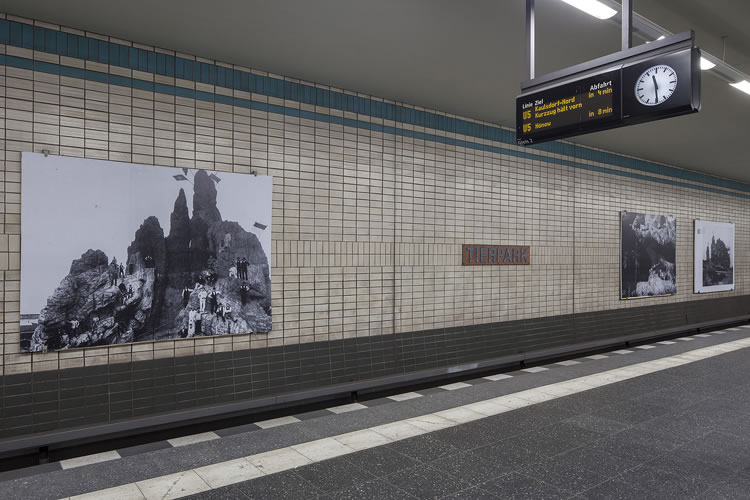
LANDSCAPE I-IV
Die gerasterten Schwarz-Weiß-Drucke zeigen historische Aufnahmen aus dem Tierpark Hagenbeck in Hamburg. Die abgebildete Berglandschaft wurde zwischen 1905 und 1907 von dem Schweizer Bildhauer Eggenschwyler erbaut. Im Landschaftspanorama zeigt sich eine für den westlichen Blick erschaffene Kulisse, die eine „authentische“ Erfahrung vom „Abstraktum Afrika“ vermitteln sollte. Hier wurde eine Bühne gebaut, die wenig mit der eigentlichen Landschaft zu tun hatte, sondern als Projektionsfläche exotistischer Vorstellungen diente. In jener zoologischen Landschaftskonstruktion zeigt sich die perfektionierte Umsetzung einer gitterfreien Tierhaltung, durch die dem damaligen Besucher die Illusion der Nahbarkeit des Wilden und Fremden geboten werden sollte.
LANDSCAPE I-IV
These half-tone black-and-white prints show historical shots of Hagenbeck Zoo in Hamburg. The landscape of hills depicted was created by the Swiss sculptor Eggenschwyler between 1905 and 1907. This landscape panorama shows a scene created for a western perspective, one intended to convey an authentic experience of the abstract notion of Africa. A setting was created here that had little in common with the actual landscape, but instead served as a projection surface for exotic imaginary concepts. This artificial zoological landscape is a perfect realisation of a fence-free environment for keeping animals which provided visitors at the time with an illusion of the approachability of the wild and exotic.
NACH DER ARBEIT - Kunst im Untergrund ist ein Projekt der neuen Gesellschaft für bildende Kunst e.V. (nGbK), initiiert von Uwe Jonas, Jochen Becker, Olivia Reynolds, Julia Staszak, Hans Winkler und Ella Ziegler.
Gefördert aus Mitteln | Funded by
Regierender Bürgermeister / Senatskanzlei - Kulturelle Angelegenheiten / Kunst im Stadtraum und am Bau.

Unterstützt von | Supported by

-Gestaltung / Umsetzung: Sven Bäucker, Natascha Schuler / MOKIK -